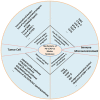Evolution of Lung Cancer in the Context of Immunotherapy
- PMID: 33447125
- PMCID: PMC7780173
- DOI: 10.1177/1179554920979697
Evolution of Lung Cancer in the Context of Immunotherapy
Abstract
Immunotherapy, as a novel treatment, has brought new hope to many patients with cancer, including patients with lung cancer. However, the overall cure rate and survival rate of lung cancer are still not satisfactory. The process of evolution has improved the ability of tumors to adapt to immunotherapy, which induces drug resistance. Many studies have focused on immunoresistance and achieved meaningful results. Therefore, it is necessary to have an in-depth understanding of the current research progress in immunoresistance, which will help to achieve good clinical results more efficiently.
Keywords: Lung cancer; cancer evolution; drug resistance; immunotherapy.
© The Author(s) 2020.
Conflict of interest statement
Declaration of conflicting interests:The author(s) declared no potential conflicts of interest with respect to the research, authorship, and/or publication of this article.
Figures


References
-
- Global Burden of Disease Cancer Collaboration, Fitzmaurice C, Akinyemiju TF, Al Lami FH, et al. Global, regional, and national cancer incidence, mortality, years of life lost, years lived with disability, and disability-adjusted life-years for 29 cancer groups, 1990 to 2016: a systematic analysis for the global burden of disease study. JAMA Oncol. 2018;4:1553-1568. - PMC - PubMed
-
- Siegel RL, Miller KD, Jemal A. Cancer statistics. CA. 2017;67:7-30. - PubMed
-
- Nowell PC. The clonal evolution of tumor cell populations. Science (New York, NY). 1976;194:23-28. - PubMed
-
- Baslan T, Hicks J. Unravelling biology and shifting paradigms in cancer with single-cell sequencing. Nat Rev Cancer. 2017;17:557-569. - PubMed
Publication types
LinkOut - more resources
Full Text Sources

